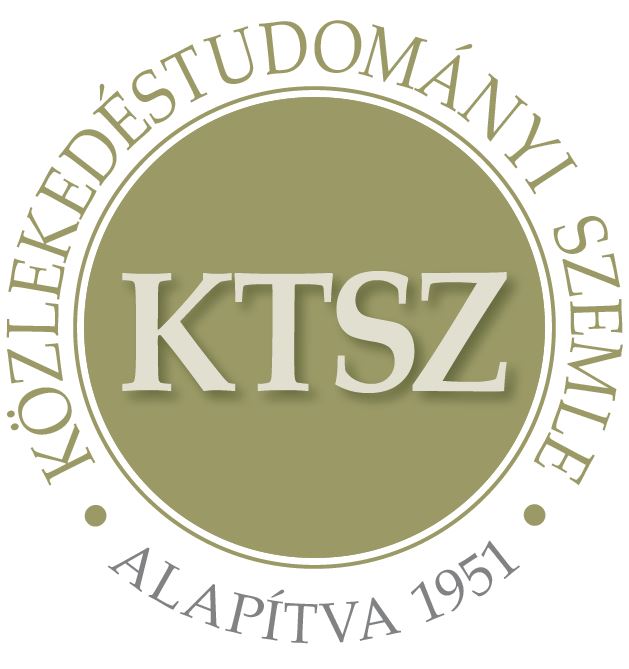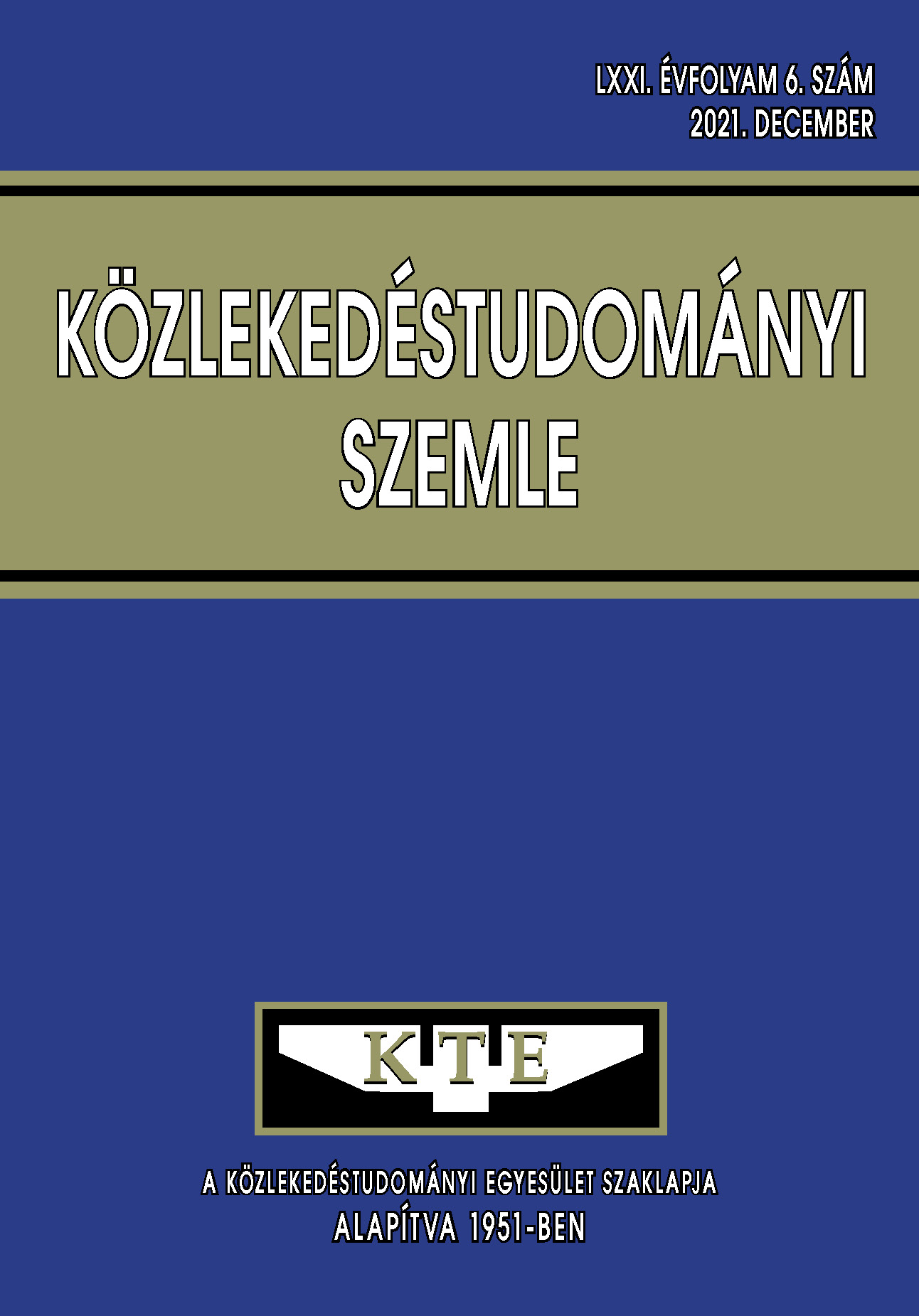Determination of road vehicle motion model by constrained multiple model filtering procedures
Abstract
The paper presents a solution based on traditional methods for manoeuvring detection in road traffic. The method works in a multiple model structure with Kálmán filters and particle filters. Each manoeuver is defined and fitted into the elementary filters using different state constraints so that a unique filter is associated with each manoeuver. The multiple model structure evaluates the accuracy of the estimation of each filter and accepts the manoeuver associated with the better performing filter as current. The efficiency of the procedure is demonstrated in a simulated traffic situation where the observed object was examined from the perspective of the observation vehicle.
References
X. R. Li and V. P. Jilkov, “Survey of maneuvering target tracking. part v. multiple-model methods,” IEEE Transactions on Aerospace and Electronic Systems, vol. 41, no. 4, pp. 1255–1321, 2005. DOI: https://doi.org/fn8tfr
H. A. Blom and Y. Bar-Shalom, “The interacting multiple model algorithm for systems with markovian switching coefficients,” IEEE transactions on Automatic Control, vol. 33, no. 8, pp. 780–783, 1988. DOI: https://doi.org/cwbf76
E. Mazor, A. Averbuch, Y. Bar-Shalom, and J. Dayan, “Interacting multiple model methods in target tracking: a survey,” IEEE Transactions on aerospace and electronic systems, vol. 34, no. 1, pp. 103–123, 1998. DOI: https://doi.org/c9b8j9
Y. Bar-Shalom, X. R. Li, and T. Kirubarajan, Estimation with applications to tracking and navigation: theory algorithms and software. John Wiley & Sons, 2004. DOI: https://doi.org/dfqbsw
Z. Messaoudi, A. Ouldali, and M. Oussalah, “Comparison of interactive multiple model particle filter and interactive multiple model unscented particle filter for tracking multiple manoeuvring targets in sensors array,” in Cybernetic Intelligent Systems (CIS), 2010 IEEE 9th International Conference on. IEEE, 2010, pp. 1–6. DOI: https://doi.org/bbrxrf
M. Zhang and W. Chen, “Variable structure multiple model particle filter for maneuvering radar target tracking,” in Microwave and Millimeter Wave Technology (ICMMT), 2010 International Conference on. IEEE, 2010, pp. 1754-1757. DOI: https://doi.org/cvvkz2
Törő, O., Bécsi, T., Aradi, S. and Gáspár, P., 2018. Imm bernoulli filter for cooperative object tracking in road traffic. IFACPapersOnLine, 51(9), pp.355-360. DOI: https://doi.org/gt4j
Törő, O., Bécsi, T., Aradi, S. and Gáspár, P., 2018. IMM Bernoulli Gaussian Particle Filter. IFAC-PapersOnLine, 51(22), pp.274-279. DOI: https://doi.org/gt4k
D. Simon, Optimal state estimation : Kalman, H_∞ and nonlinear approaches. Hoboken, N.J: Wiley-Interscience, 2006. DOI: https://doi.org/bmzttv
Teixeira, B. O., Chandrasekar, J., Tôrres, L. A., Aguirre, L. A., & Bernstein, D. S. (2009). State estimation for linear and non-linear equality-constrained systems. International Journal of Control, 82(5), 918-936. DOI: https://doi.org/bfwshc
O. Törő, T. Bécsi, and S. Aradi, “Design of lane keeping algorithm of autonomous vehicle,” Periodica Polytechnica Transportation Engineering, vol. 44, no. 1, pp. 60–68, 2016. DOI: https://doi.org/ggfvvq
Z. Zhao, B. Huang, and F. Liu, “Constrained particle filtering methods for state estimation of nonlinear process,” AIChE Journal, vol. 60, no. 6, pp. 2072–2082, 2014. DOI: https://doi.org/gt4m
Chen, Z., 2003. Bayesian filtering: From Kalman filters to particle filters, and beyond. Statistics, 182(1), pp.1-69. DOI: https://doi.org/bkztpw
A. A. Saucan, T. Chonavel, C. Sintes, and J. M. L. Caillec, “Interacting multiple model particle filters for side scan bathymetry,” in 2013 MTS/IEEE OCEANS - Bergen, June 2013, pp. 1–5. DOI: https://doi.org/gt4n
Articles published electronically are open access (OJS), freely available online and can be downloaded. Authors of articles are not charged any publication or publishing costs (APC). Users have the right to read, download, copy, print, and search the articles, or share the full text with a link.
Authors must declare that their submission has not been previously published in another journal, that financial support has been acknowledged, and that the list of references is complete and accurate, including specification of URLs and DOIs (if available). When submitting a draft article, each author approves the submitted version. Authors guarantee that the article is their original work. Authors are required to participate in the peer review process, follow the advice of reviewers, meet the prescribed deadlines, and, if any, withdraw the submission or correct errors.
All submitted articles are subject to peer review, where the editors request an independent evaluation from at least one expert, ensuring that the reviewer(s) have no conflicts of interest with the authors. The final decision is made by the Editor-in-Chief, who takes into account the evaluations and the suggestions of the editors. The editors and reviewers treat the submission confidentially.
The publisher and editors are committed to maintaining high ethical standards and to preventing publications that involve research misconduct. They follow the COPE guidelines on such ethical issues.
The authors retain copyright and grant the journal the right of first publication under the Creative Commons License (https://creativecommons.org/licenses/by-nc-nd/4.0), which allows others to share the work, while acknowledging the authorship of the work and the first publication in the journal.
The journal archives all published articles, and the journal's owner, the Hungarian Society of Transportation Sciences, will continue to operate the database even if the journal ceases to be published.















